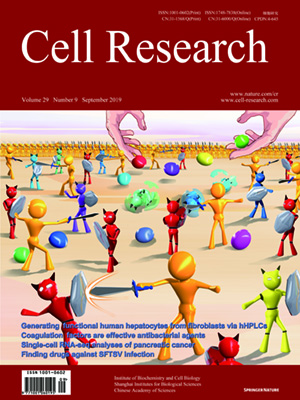
Advanced Search
Submit Manuscript
Advanced Search
Submit Manuscript
Volume 29, No 9, Sep 2019
ISSN: 1001-0602
EISSN: 1748-7838 2018
impact factor 17.848*
(Clarivate Analytics, 2019)
Volume 29 Issue 9, September 2019: 696-710 |
Bingqing Xie 1,2, Da Sun 1,2, Yuanyuan Du1, Jun Jia1, Shicheng Sun 1, Jun Xu1, Yifang Liu3, Chengang Xiang1, Sitong Chen1,Huangfan Xie 1, Qiming Wang1, Guangya Li1, Xuehui LYU4, Hui Shen4, Shiyu Li4, Min Wu5, Xiaonan Zhang5, Yue Pu6, Kuanhui Xiang7,Weifeng Lai1, Peng Du4, Zhenghong Yuan8, Cheng Li3, Yan Shi1, Shichun Lu9 and Hongkui Deng 1,2
1School of Basic Medical Sciences, State Key Laboratory of Natural and Biomimetic Drugs, Peking University Health Science Center and the MOE Key Laboratory of Cell Proliferation and Differentiation, College of Life Sciences, Peking-Tsinghua Center for Life Sciences, Peking University, Beijing 100191, China; 2State Key Laboratory of Chemical Oncogenomics, School of Chemical Biology & Biotechnology, Peking University Shenzhen Graduate School, Shenzhen, Guangdong 518055, China; 3Center for Bioinformatics, Peking University, Beijing 100871, China; 4MOE Key Laboratory of Cell Proliferation and Differentiation, College of Life Sciences, Peking-Tsinghua Center for Life Sciences, Peking University, Beijing 100871, China; 5Shanghai Public Health Clinical Center, Shanghai 201508, China; 6Hangzhou Repugene Technology Co,. Ltd, Hangzhou, China; 7School of Basic Medical Sciences, Peking University Health Science Center, Beijing 100191, China; 8Key Laboratory of Medical Molecular Virology, Fudan University, Shanghai 200032, China and 9Department of Hepatobiliary Surgery, Chinese PLA General Hospital, Beijing 100853, China
https://doi.org/10.1038/s41422-019-0196-x